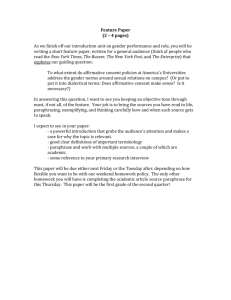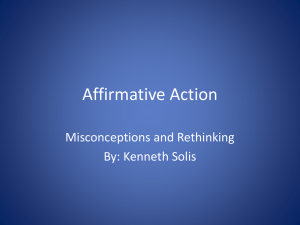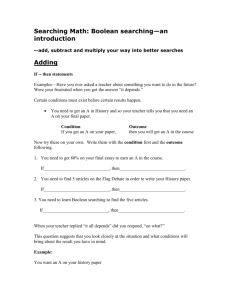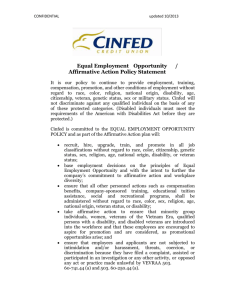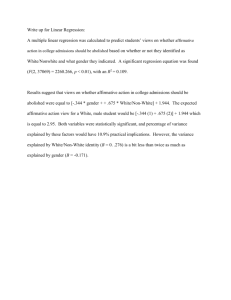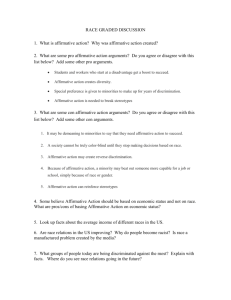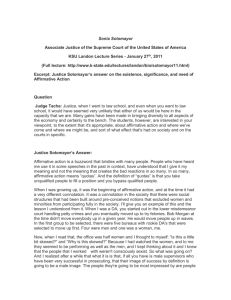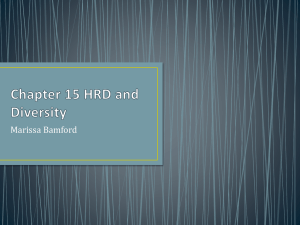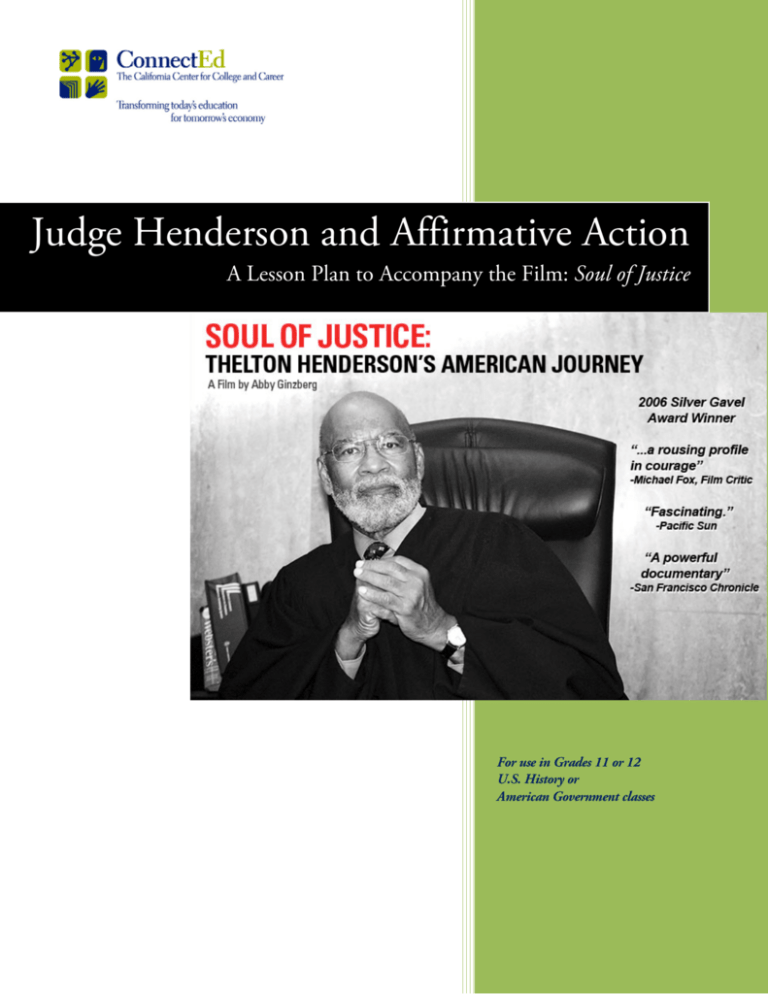
Judge Henderson and Affirmative Action
A Lesson Plan to Accompany the Film: Soul of Justice
For use in Grades 11 or 12
U.S. History or
American Government classes
ConnectEd: The California Center for College and Career
Judge Henderson and Affirmative Action
Judge Henderson and Affirmative Action
U.S. History or
American
Government
Duration
Five 55 minute class periods
Materials
x “Soul of Justice” video
x Article “Affirmative
Action in the United
States”
x Political cartoons
x Six articles on
affirmative action
x “By the Numbers” fact
sheet
x Knowledge Web
x Chart paper and colored
markers
Prior Student Learning
Students should have some
knowledge of the history of race
relations in the past century
Essential Question for This Unit
How do we learn about racial justice and public policy by using multiple sources
and considering diverse points of view?
Objectives
After completing this lesson, students should be able to
x collect, assess, and use information from multiple sources and apply it in
oral and written presentations.
x show the connections between particular historical events and larger
social developments.
x
listen to and build on the ideas of others.
x
become aware of, and increasingly control, their own habits of learning
and inquiry.
Lesson Springboard
I think people voted for 209 idealistically and generally thought it would
produce a fairer system. My conclusion, and the conclusion of many people
around me, is that because it has resulted in a dramatic diminution in
numbers of particular classes of California citizens, it has in fact created a
system that is quite unfair. . . Instead of ensuring nondiscrimination,
Proposition 209 has created an environment that many students of color
view as discriminatory. That's because minority representation has dropped
appallingly, and where there should be camaraderie across cultural lines, I
have seen too much alienation, mistrust and division.
-University of California Chancellor Robert Birgeneau
In 1996, California’s Proposition 209 outlawed affirmative action in public
contracts, hiring, and college admissions, threatening the gains won by
minorities at great cost during the ‘60s. However, Judge Thelton
Henderson ruled the proposition unconstitutional. Despite the judge’s
concern for impartiality and careful legal reasoning, Republican lawmakers
called for his impeachment, denouncing him as a "judicial activist” and
working to overturn his decision on appeal.
This lesson invites students to follow in Judge Henderson’s footsteps as they
reflect on the hard question of affirmative action from multiple points of
view. They are required to interpret a variety of sources and to deliberate
together in their effort to reach an understanding of this subject.
Copyright © 2012 by ConnectEd: The California Center for College and Career. All rights reserved
Page 2 of 25
ConnectEd: The California Center for College and Career
Judge Henderson and Affirmative Action
Lesson Activities
First Class Period
Note to teachers:
The running time of “Soul
of Justice” is 60 minutes.
The subject of Proposition
209 and affirmative action
appears from 36:37 to
45:55 in the video.
Students begin by watching the first four parts of the video Soul of Justice,
on Henderson’s early career and his role in the Civil Rights Movement
(CRM) of the 1960s. (36 minutes) Class discussion is inspired by questions
that relate the video to students’ prior lessons on the CRM. At the
conclusion of the period, students are assigned as homework an article,
“Affirmative Action in the United States,” which introduces the subject and
prepares them for the conclusion of Soul of Justice: Henderson’s decision
and the furor that surrounded it.
Second Class Period
Students discuss the homework article through a series of questions that
they will revisit at the end of the period. Then they view the conclusion of
the video Soul of Justice, a 24-minute segment that includes ten minutes on
Judge Henderson and Proposition 209. Following the video, students have
the opportunity to reexamine the questions raised at the beginning of class.
Third Class Period
Students are assigned to groups of four. Each group gets a set of four
different colored markers, a piece of chart paper, texts, and loose leaf paper.
First Round: The Mystery Texts (30 minutes)
Students receive a set of five political cartoons that are pro- and antiaffirmative action. There is a certain ambiguity and even mystery to these
cartoons that calls for strong interpretation. The students discuss the
cartoons and write one to two paragraphs on loose leaf paper interpreting
them. Students then record what they know about the topic of affirmative
action in their journals. Remaining in small groups, they share what they
know about the topic and, using one of the colored markers, create a “web”
showing their collective knowledge of it. (A model for constructing this web
is provided in the Handouts section.)
Note to teachers:
As a lesson extension,
students may read the
handout “Affirmative
Action Pro and Con” and
answer the questions that
are attached. (See Handouts
below)
Second Round: The Provocative Text, part one (25 minutes)
Students from all the groups are given six short but challenging articles that
offer multiple perspectives on affirmative action. They read two or three of
these articles in class and answer the reading comprehension questions that
follow them. Then, students code the articles with “N” for new information
and add their new knowledge to the web using a different colored marker.
The remaining articles and reading comprehension questions are assigned
as homework.
Copyright © 2012 by ConnectEd: The California Center for College and Career. All rights reserved
Page 3 of 25
ConnectEd: The California Center for College and Career
Note to teachers:
For strong students,
consider these extra
readings:
http://www.balancedpolitics
.org/affirmative_action.htm
(summary of pros and cons)
http://www.pbs.org/now/sh
ows/434/affirmativeaction.html (debating
affirmative action)
Judge Henderson and Affirmative Action
Fourth Class Period
Second Round: The Provocative Text, part two (25 minutes)
Remaining in their groups, students discuss the articles they read as
homework, once again coding with “N” for new information and adding
their knowledge to the web in the same colored marker as before. (Since it is
unlikely that every student understood all of the articles, time should be
allowed for discussion. Some teachers may wish to extend this round to a
full class period.)
Third Round: The Informational Text (30 minutes)
Each member of the group receives “By the Numbers,” a fact sheet on race,
class, and affirmative action in America. For this round, the “text” is a set of
numbers, charts, and graphs. Students must organize and interpret this
information in light of what they have learned. Once again they discuss the
text, code it for new information, and share this knowledge on the chart
paper in a marker of a third color.
Fifth Class Period
Fourth Round: The Mystery Texts Revisited (25 minutes)
Ask students to return to the paragraphs they wrote on the political cartoons
and write about them again. (Most will want to write at greater length.)
Afterwards, in their groups, the students discuss the contrast between
their first and second encounters and reflect on what made the experience
so different. Students are invited, but not required, to add ideas to their
webs in a marker of a fourth color.
Conclusion: Building Background Knowledge (30 minutes)
Ask the class to examine the process through which we become more
informed about a complex subject . Some questions for class discussion:
x
How much did you know about the topic at first?
x
What inspired your curiosity in the first round of cartoons?
x
What more did you learn from texts in the second and third round?
x
Looking at your web, in which area did you learn the most?
x
What part of the web would you want to tell others about?
x
What was it like to encounter the cartoons a second time?
x
What do you think now about Judge Henderson’s decision on
Prop 209?
Lesson Closure
In the final class activity, students post their webs around the room and
do a “gallery walk” among them. They are encouraged to talk about the
similarities and differences among the webs, but especially about the
ways in which the webs could be combined. As a lesson extension, the
Copyright © 2012 by ConnectEd: The California Center for College and Career. All rights reserved
Page 4 of 25
ConnectEd: The California Center for College and Career
Judge Henderson and Affirmative Action
student groups could create one or several “super webs” to express the
understanding of the topic gained by the class as a whole.
Student Assessment Artifacts
x
Knowledge Web
x
Reading comprehension questions for six articles on affirmative action
x
Short essay (as lesson extension)
x
Letter or op-ed Article (as lesson extension)
Variations and Extensions
Extension 1: Students write a short argumentative essay, choosing two
affirmative action objections to refute, or two supports of affirmative action
that they will challenge.
Extension 2: Students write a letter or op-ed article to a state legislator
that explains their view of affirmative action, how it may have changed
after completing this lesson, and what policy they feel the government
should take.
State Academic and Common Core Standards
COMMON CORE STATE STANDARDS
English Language Arts
RI 11-12 1 Cite strong and thorough textual evidence to
support analysis of what the text says explicitly as well as
inferences drawn from the text, including determining
where the text leaves matters uncertain.
RI 11-12 2 Determine two or more central ideas of a text
and analyze their development over the course of the text,
including how they interact and build on one another to
provide a complex analysis; provide an objective summary of
the text.
RI 11-12 6 Determine an author’s point of view or purpose
in a text in which the rhetoric is particularly effective,
analyzing how style and content contribute to the power,
persuasiveness or beauty of the text.
W 11-12 1, W 11-12 2
W 11-12 4 Produce clear and coherent writing in which the
development, organization, and style are appropriate to
task, purpose, and audience. (Grade-specific expectations
for writing types are defined in standards 1–3 above.)
W 11-12 8 Gather relevant information from multiple
authoritative print and digital sources, using advanced
searches effectively; assess the strengths and limitations of
each source in terms of the task, purpose, and audience;
integrate information into the text selectively to maintain
the flow of ideas, avoiding plagiarism and overreliance on
any one source and following a standard format for
citation.
CALIFORNIA
Content Standards for History/Social Science
11.10 - Students analyze the development of federal civil rights
and voting rights
11.10.2 Examine and analyze the key events, policies, and court
cases in the evolution of civil rights, including Dred Scott v.
Sandford, Plessy v. Ferguson, Brown v. Board of Education, Regents
of the University of California v. Bakke, and California Proposition
209.
11.10.3 Describe the collaboration on legal strategy between
African American and white civil rights lawyers to end racial
segregation in higher education.
11.10.4 Examine the roles of civil rights advocates (e.g., A. Philip
Randolph, Martin Luther King, Jr., Malcolm X, Thurgood Marshall,
James Farmer, Rosa Parks), including the significance of Martin
Luther King, Jr.’s “Letter from Birmingham Jail” and “I Have a
Dream” speech.
11.10.5 Discuss the diffusion of the civil rights movement of African
Americans from the churches of the rural South and the urban
North, including the resistance to racial desegregation in Little Rock
and Birmingham, and how the advances influenced the agendas,
strategies, and effectiveness of the quests of American Indians,
Asian Americans, and Hispanic Americans for civil rights and equal
opportunities.
11.10.6 Analyze the passage and effects of civil rights and voting
rights legislation (e.g., 1964 Civil Rights Act, Voting Rights Act of
1965) and the Twenty-Fourth Amendment, with an emphasis on
equality of access to education and to the political process.
Copyright © 2012 by ConnectEd: The California Center for College and Career. All rights reserved
Page 5 of 25
ConnectEd: The California Center for College and Career
Judge Henderson and Affirmative Action
State Academic and Common Core Standards
COMMON CORE STATE STANDARDS
English Language Arts
CALIFORNIA
Content Standards for History/Social Science
SL 11-12 1, SL 11-12 2 Integrate multiple sources of
information presented in diverse formats and media (e.g.,
visually, quantitatively, orally) in order to make informed
decisions and solve problems, evaluating the credibility and
accuracy of each source and noting any discrepancies among
the data.
12.1 Students explain the fundamental principles and moral values
of American democracy as expressed in the U.S. Constitution and
other essential documents of American democracy.
SL 11-12 3 Evaluate a speaker’s point of view, reasoning,
and use of evidence and rhetoric, assessing the stance,
premises, links among ideas, word choice, points of
emphasis, and tone used.
SL 11-12 4 Present information, findings, and supporting
evidence, conveying a clear and distinct perspective, such
that listeners can follow the line of reasoning, alternative or
opposing perspectives are addressed, and the organization,
development, substance, and style are appropriate to
purpose, audience, and a range of formal and informal
tasks.
12.1.5 Describe the systems of separated and shared powers, the
role of organized interests (Federalist Paper Number 10), checks
and balances (Federalist Paper Number 51), the importance of an
independent judiciary (Federalist Paper Number 78), enumerated
powers, rule of law, federalism, and civilian control of the military.
12.1.6. Understand that the Bill of Rights limits the powers of the
federal government and state governments.
12.5 Students summarize landmark U.S. Supreme Court
interpretations of the Constitution and its amendments.
12.5.1 Understand the changing interpretations of the Bill of Rights
over time, including interpretations of the basic freedoms (religion,
speech, press, petition, and assembly) articulated in the First
Amendment and the due process and equal-protection-of-the- law
clauses of the Fourteenth Amendment.
12.5.2 Analyze judicial activism and judicial restraint and the effects
of each policy over the decades (e.g., the Warren and Rehnquist
courts).
12.5.4 Explain the controversies that have resulted over changing
interpretations of civil rights, including those in Plessy v. Ferguson,
Brown v. Board of Education, Miranda v. Arizona, Regents of the
University of California v. Bakke, Adarand Constructors, Inc. v. Pena,
and United States v. Virginia (VMI).
Copyright © 2012 by ConnectEd: The California Center for College and Career. All rights reserved
Page 6 of 25
ConnectEd: The California Center for College and Career
Judge Henderson and Affirmative Action
Lesson Handouts AFFIRMATIVE ACTION IN THE UNITED STATES ........................................................................................ 8 FIRST ROUND: THE MYSTERY TEXTS - PRO- AND ANTI-AFFIRMATIVE ACTION POLITICAL
CARTOONS ....................................................................................................................................................... 10 CARTOON #1 ...................................................................................................................................... 10 CARTOON #2 ...................................................................................................................................... 10 CARTOON #3 ...................................................................................................................................... 10 CARTOON #4 ...................................................................................................................................... 10 CARTOON #5 ...................................................................................................................................... 10 SAMPLE TEMPLATE FOR A KNOWLEDGE WEB ...................................................................................... 11 SECOND ROUND: THE PROVOCATIVE TEXT - SIX READINGS ON AFFIRMATIVE ACTION ........... 12 WE STILL HAVE FAR TO GO............................................................................................................ 12 THE HARM OF RACIAL PREFERENCES ......................................................................................... 13 RELY ON MERIT, NOT RACE ........................................................................................................... 14 IN FISHER V. TEXAS, LOOK AT THE POLITICS ............................................................................ 15 KNOWING WHEN RACE MATTERS ............................................................................................... 16 A CONSTITUTIONAL AND FAIR POLICY ...................................................................................... 17 THIRD ROUND: THE INFORMATIONAL TEXT - BY THE NUMBERS FACT SHEET .............................. 18 ARGUMENTS FOR AND AGAINST RACE-BASED AFFIRMATIVE ......................................................... 23 Copyright © 2012 by ConnectEd: The California Center for College and Career. All rights reserved
Page 7 of 25
ConnectEd: The California Center for College and Career
Judge Henderson and Affirmative Action
Affirmative Action in the United States
More than a half century since it began, affirmative action has produced a legacy of
successes, including a revolution in recruiting and hiring. But it has caused persistent
resentment and failed to eliminate poverty or racism.
The affirmative action program began with World War II when President Franklin
Roosevelt signed the executive order barring discrimination in the federal government and
by war industries. The executive order outlawed discrimination against blacks by defense
contractors and it also set up the first Fair Employment Practices Committee. Compliance,
though, was imperfect; the programs lacked enforcement and funds.
Affirmative action gained muscle in the 1960s with the rise of the civil rights movement.
Explicitly, it has been about race, and to a lesser degree, gender — a policy to make up for
centuries of oppression and to ensure diversity. But there has always been a broader
notion to affirmative action as well. It has been the most serious effort of any kind to
ensure equality of opportunity in education and hiring, without regard to wealth or
poverty. When all else failed — the War on Poverty, welfare, public schools — the system
enabling preferential treatment would be there to help less-fortunate Americans
overcome the circumstances of their origins.
Executive order 10925, issued by President John F. Kennedy in March 6, 1961, established
the Committee on Equal Employment Opportunity, mandating that projects given federal
funds take affirmative action to keep racial bias out of employment and hiring practices.
But it was the Civil Right Act signed by President Lyndon Johnson in 1964 that effectively
outlawed discrimination and breathed life into the idea of equal opportunity. In 1965, Mr.
Johnson issued Executive Order 11246, which required federal contractors to take
affirmative action in hiring employees without regard to race, religion and national origin.
Three years later, gender was added to the protected categories.
Meeting Staunch Opposition
Affirmative action, however, met staunch opposition from a number of communities, ,
who assailed what they called a quota system. Some leaders feared that it would create
polarization, jeopardizing the economic and political status of Jewish and white middleclass people — that it was, in effect, reverse discrimination. Jewish people have long
argued against the quotas of elite universities and colleges that were used to exclude
them, regardless of academic merit. Some Jewish groups saw minority admissions
programs as the reworking of the old, disreputable system.
Courts have tended to rule against colleges and universities that use strict numerical
solutions to remedy racial imbalances. The Bakke case would become a famous salvo
galvanizing both sides of the affirmative action debate.
Allan P. Bakke, a white man, challenged a special admission program at the medical school
of UC Davis. Mr. Bakke said the special program had discriminated against him on the basis
of race, and the California State Supreme Court agreed. The case, which went to the U.S.
Supreme Court, was perhaps the most important race relations lawsuit since the 1954
Brown v. Board of Education decision on school desegregation.
Copyright © 2012 by ConnectEd: The California Center for College and Career. All rights reserved
Page 8 of 25
ConnectEd: The California Center for College and Career
Judge Henderson and Affirmative Action
In its 1978 landmark Regents v. Bakke decision, the court ruled 5-4 that it was
unconstitutional for a state school to reserve a limited number of places for qualified
minority applicants. It said, however, that race could be taken into consideration in
deciding admission — that race could be a “plus factor.” The decision meant that the great
majority of affirmative action programs, both public and private, could continue — along
with the escalating debates and lawsuits over what constitutes racial balance.
In the early 1990s, elite campuses began to pull back from their aggressive affirmativeaction policies. And in 1996, California voters passed the California Civil Rights Initiative, or
Proposition 209. After that, race could no longer be a factor in government hiring or
public-university admissions. The number of black students at both Berkeley and UCLA
plummeted, and at UCLA the declines continued throughout the next decade. In 1997, the
freshman class included 221 black students; in 2006, it had only 100. In the region with
easily the largest black population west of the Mississippi River, the top public university
had a freshman class in which barely 1 in 50 students was black.
High Court Ruling
More than a quarter century after Bakke, the high court ruled again in favor of affirmative
action, but with qualifications. In a 6-3 vote, it struck down the University of Michigan’s
undergraduate admissions program, in which students were evaluated on a 150-point scale
that awarded 20 points for being a member of an underrepresented minority group.
However, in a 5-4 ruling, the court upheld Michigan’s law school program in which
decisions were made by an admissions committee without a numerical scale. . .
Much of the justification for affirmative action in other arenas has concerned the righting
of past wrongs, and thus faces a time limit: when the playing field has been leveled, such
policies will no longer be needed. But if a mixed campus is considered in the state’s
interest because it improves everyone’s education, then racial preferences would be
defensible for years to come.
Finding ‘Wiggle Room’ in Court Decisions
In December 2011, the Obama administration urged colleges and universities to get
creative in improving racial diversity at their campuses, throwing out a Bush-era
interpretation of rulings that limited affirmative action in admissions.
The guidelines issued by the Departments of Justice and Education in a 10-page guide
replaced a 2008 document that essentially warned colleges and universities against
considering race at all. Instead, the guidelines focus on the wiggle room in court decisions
involving the University of Michigan, suggesting that institutions use other criteria —
students’ socioeconomic profiles, residential instability, the hardships they have overcome
— that are often proxies for race. Schools could even grant preferences to students
from certain schools selected for, among other things, their racial composition, the
document says.
Adapted from The New York Times:
http://topics.nytimes.com/topics/reference/timestopics/subjects/a/affirmative_action/index.h
tml
Copyright © 2012 by ConnectEd: The California Center for College and Career. All rights reserved
Page 9 of 25
ConnectEd: The California Center for College and Career
Judge Henderson and Affirmative Action
First Round: The Mystery Texts
Pro- and Anti-Affirmative Action Political Cartoons
Cartoon #1
Source: http://www.cartoonistgroup.com/store/add.php?iid=7835
Cartoon #2
Source: http://3.bp.blogspot.com/_ufCikM8JCvU/SWKJ4Pxu2HI/AAAAAAAAEzU/V-xPPHAj5so/s400/b6489442.gif
Cartoon #3
Source: http://www.amptoons.com/blog/2006/06/02/anti-affirmative-action-cartoon-on-this-weeks-new-yorker/
Cartoon #4
Source: http://www.opencongress.org/w/images/7/71/Affirmative-action_cartoon.gif
Cartoon #5
Source: http://www.cartoonistgroup.com/store/add.php?iid=18870
Copyright © 2012 by ConnectEd: The California Center for College and Career. All rights reserved
Page 10 of 25
ConnectEd: The California Center for College and Career
Judge Henderson and Affirmative Action
Sample Template for a Knowledge Web
Pros and
Cons of
AffirmAct
Affirm.
Action:
when &
where?
What is
affirmative
action?
Copyright © 2012 by ConnectEd: The California Center for College and Career. All rights reserved
Page 11 of 25
ConnectEd: The California Center for College and Career
Judge Henderson and Affirmative Action
Second Round: The Provocative Text
Six Readings on Affirmative Action
Reading #1: We Still Have Far to Go by Patricia J. Williams
http://www.nytimes.com/roomfordebate/2012/02/22/beyond-race-in-affirmative-action/we-still-have-far-togo-in-the-quest-for-diversity-on-campus
Building Word Knowledge
Author Patricia Williams refers to “new categories of the historically disenfranchised”
(paragraph 1); an argument that “is not merely hypocritical but foolish” (paragraph 2),
and the “disingenuous hoopla” from people who claim that race no longer matters in
our society (paragraph 5). She also mentions the “de facto disparity” between the races
in college attendance (paragraph 2). From the context in which they appear, define these
words. Find three other words in the essay that can be understood from their context and
use a dictionary, if needed, to define them.
Comprehending the Essay
Answer these questions in one or two complete sentences.
The author gives several reasons why we should still be concerned about the small number
of blacks and Hispanics who attend college. What is one of these reasons?
Why does the author approve of the Texas Top Ten Plan? What do you think its critics
might say about the plan?
Copyright © 2012 by ConnectEd: The California Center for College and Career. All rights reserved
Page 12 of 25
ConnectEd: The California Center for College and Career
Judge Henderson and Affirmative Action
Reading #2: The Harm of Racial Preferences by Peter H. Schuck
http://www.nytimes.com/roomfordebate/2012/02/22/beyond-race-in-affirmative-action/race-basedpreferences-are-corrosive-public-policy
Building Word Knowledge
In English, certain words frequently appear together. These word partners are called
“collocations.” In this essay, author Peter Shuck uses three collocations often found in
writings about race and education. Define these terms:
x
race-conscious (paragraph 1)
x
race-based (paragraphs 2 and 4)
x
race-neutral (paragraph 2)
Comprehending the Essay
In paragraphs two and three, the author explains why he opposes the affirmative action
plan in Texas. Summarize his view in two to four sentences.
Copyright © 2012 by ConnectEd: The California Center for College and Career. All rights reserved
Page 13 of 25
ConnectEd: The California Center for College and Career
Judge Henderson and Affirmative Action
Reading #3: Rely on Merit, Not Race by Stephen Hsu
http://www.nytimes.com/roomfordebate/2012/02/22/beyond-race-in-affirmative-action/merit-not-race-incollege-admissions
Building Word Knowledge
Author Stephen Hsu uses three words or phrases that identify important characteristics of
higher education in America today: “legacy students,” “elite universities,” and “the
meritocratic ideal.” Define the words in boldface and, in one or two sentences, explain
how these phrases relate to college students.
Comprehending the Essay
The author asks “Would students admitted through race-based preference be better off at
somewhat less elite universities where their abilities are better matched to those of their
classroom peers? In three to four sentences, explain the strengths or weaknesses of this
view. For example, are there benefits to “race-based preferences” other than achievement
in the classroom?
Copyright © 2012 by ConnectEd: The California Center for College and Career. All rights reserved
Page 14 of 25
ConnectEd: The California Center for College and Career
Judge Henderson and Affirmative Action
Reading #4: In Fisher v. Texas, Look at the Politics by Ian Haney-Lopez
http://www.nytimes.com/roomfordebate/2012/02/22/beyond-race-in-affirmative-action/in-fisher-v-texaslook-at-the-politics
Building Word Knowledge
Many words can be learned using the context in which they appear. Try to define these
words from their context, then check your definitions by looking them up in a dictionary.
electoral politics
a foil in the culture wars
the coddling of criminals
mobilize voters
devastating development
banning discrimination as ineffective
curtailed every direct means
campaign resounds with themes
Comprehending the Essay
In one or two sentences, explain why the author thinks that the Supreme Court in Fisher v.
Texas will declare affirmative action unconstitutional.
In the final paragraph, why does the author lump together with affirmative action such
diverse issues as gay marriage, abortion, and contraception? In other words, why does he
view these issues as related?
Copyright © 2012 by ConnectEd: The California Center for College and Career. All rights reserved
Page 15 of 25
ConnectEd: The California Center for College and Career
Judge Henderson and Affirmative Action
Reading #5: Knowing When Race Matters by Vikram Amar
http://www.nytimes.com/roomfordebate/2012/02/22/beyond-race-in-affirmative-action/knowing-when-totake-race-into-account
Building Word Knowledge
Working with a partner, find eight words in this article you don’t know. Learn four of
them and teach them to your partner, then switch roles. When you’re done, see if
together you can define all eight words.
Comprehending the Essay
Is affirmative action a good thing? The author seems uncertain. In one to three sentences,
state two reasons he gives for supporting it, and two reasons for why it should be
opposed.
What does the author mean when he says in the last paragraph that people who “care
about the original understanding of the Constitution’s terms that the framers of the Equal
Protection Clause themselves used race-based laws to help African-Americans as a class”?
Before responding, ask yourself where you would look for information about the “Equal
Protection Clause,” which is part of the 14th amendment of the U.S. Constitution. Then
consult this source – a book, internet article, or person – to help you respond.
Copyright © 2012 by ConnectEd: The California Center for College and Career. All rights reserved
Page 16 of 25
ConnectEd: The California Center for College and Career
Judge Henderson and Affirmative Action
Reading #6: A Constitutional and Fair Policy by Jeffrey Rosen
http://www.nytimes.com/roomfordebate/2012/02/22/beyond-race-in-affirmative-action/race-basedpreferences-are-constitutional-and-fair
Building Word Knowledge
To read and write well, it is important to learn all the members of a word family so that
you can use the right form of the word. Here are some words from this essay, “A
Constitutional and Fair Policy,” along with other members of their word families. Learn
these words and find one other word in the reading that is a member of a word family.
restrictions (noun)
restrict (verb)
restricted (adjective)
compelling (adjective)
compel (verb)
compulsion (noun)
precedent (noun)
precede (verb)
preceding (adjective)
Comprehending the Essay
When you read, it’s important to find the main idea, which may sometimes be expressed in
a single phrase or sentence. In this article, the main idea is stated in the opening sentence
of paragraph three: “Kennedy’s worries that affirmative action — like restrictions on
corporate campaign funding — may “destroy confidence” in the Constitution are
uninformed by empirical evidence.” In two or three sentences, explain what the author
means by this.
Copyright © 2012 by ConnectEd: The California Center for College and Career. All rights reserved
Page 17 of 25
ConnectEd: The California Center for College and Career
Judge Henderson and Affirmative Action
Third Round: The Informational Text
By The Numbers Fact Sheet
Below are charts showing the 25%, 50% and 75th percentile LSAT scores of Black, Hispanic, Asian,
and White admittees at Arizona, Arizona State, and Nebraska. To check your understanding, locate
the 50% percentile for Hispanics and Asians in 2007 and find the difference in scores. (Source:
Center for Equal Opportunity, a conservative policy-research firm)
Source: http://taxprof.typepad.com/.shared/image.html?/photos/uncategorized/2008/10/08/arizona.jpg
Copyright © 2012 by ConnectEd: The California Center for College and Career. All rights reserved
Page 18 of 25
ConnectEd: The California Center for College and Career
Judge Henderson and Affirmative Action
Source: http://taxprof.typepad.com/.shared/image.html?/photos/uncategorized/2008/10/08/asu_law.jpg
http://taxprof.typepad.com/.shared/image.html?/photos/uncategorized/2008/10/08/nebraska.jpg
Copyright © 2012 by ConnectEd: The California Center for College and Career. All rights reserved
Page 19 of 25
ConnectEd: The California Center for College and Career
Judge Henderson and Affirmative Action
Racial/Ethnic Distribution of New Undergraduates: University of California
(UC) wide 1999-2010
Source: http://accountability.universityofcalifornia.edu/documents/accountabilityreport11.pdf
Copyright © 2012 by ConnectEd: The California Center for College and Career. All rights reserved
Page 20 of 25
ConnectEd: The California Center for College and Career
Judge Henderson and Affirmative Action
Economic Opportunities Among Women and Blacks
The following chart shows the leading economic indicators for women since 1966.
Keep in mind that affirmative action for women did not start until the late 60s; it
was most vigorously enforced in the 70s, and less enforced in the 80s.
Poverty Unempl. Labor
Year Rate
Rate
Median FT,YR male/
Partic. Income female ratio
--------------------------------------------------------------
1966
1967
1968
1969
1970
1971
1972
1973
1974
1975
1976
1977
1978
1979
1980
1981
1982
1983
1984
1985
1986
1987
1988
1989
1990
1991
1992
1993
1994
16.3%
15.8
14.3
13.6
14.0
14.1
13.4
12.5
12.9
13.8
13.4
13.0
13.0
13.2
14.7
15.8
16.5
16.8
15.9
15.6
15.2
15.0
14.5
14.4
15.2
16.0
16.6
16.9
16.3
4.8
5.2
4.8
4.7
5.9
6.9
6.6
6.0
6.7
9.3
8.6
8.2
7.2
6.8
7.4
7.9
9.4
9.2
7.6
7.4
7.1
6.2
5.6
5.4
5.5
6.4
7.0
6.6
6.0
38.3
39.0
39.6
40.7
40.8
40.4
41.0
42.0
42.6
42.0
43.2
44.5
46.4
47.5
47.7
48.0
47.7
48.0
49.5
50.4
51.4
52.5
53.4
54.3
54.3
53.7
53.8
54.1
55.3
6,896
7,353
7,937
8,019
8,027
8,280
8,675
8,779
8,801
8,926
8,922
9,241
8,932
8,716
8,860
8,978
9,126
9,402
9,796
9,940
10,290
10,821
11,129
11,502
11,418
11,399
11,317
11,329
11,466
.576
.578
.582
.589
.594
.595
.579
.566
.588
.588
.602
.589
.594
.597
.602
.592
.617
.636
.637
.646
.643
.652
.660
.687
.716
.699
.708
.715
.720
Note: Female economic indicators, individual.
Median income: 15 years and older, income
adjusted for inflation. Female labor force
participation rate: 16 years and older. Income
ratio: full-time, year-round female to male
median earnings.
Discussion Questions:
How has the percentage of women
participating in the labor force changed
between 1966 and 1994? Second, women
made roughly 59 cents to every man's
dollar in the mid- to late 1960’s. How
would you describe the change? Based
on what you know about Affirmative
Action enforcement, what can you
conclude about the influence of
affirmative action on women’s earnings
during the period in this table?
Source: http://www.huppi.com/kangaroo/L-aahelp.htm
Copyright © 2012 by ConnectEd: The California Center for College and Career. All rights reserved
Page 21 of 25
ConnectEd: The California Center for College and Career
Judge Henderson and Affirmative Action
For blacks the history of affirmative action reads a bit differently, in two ways. First
of all, blacks have always been concentrated in the nation's lowest-paying and
most menial jobs. Unlike women, blacks were underrepresented not only in
managerial/professional jobs but in ordinary middle class jobs as well. Since the
qualifications for the latter are less than the former, what can be inferred about
black gains and the rate at which they were accomplished? Second of all,
affirmative action began addressing racial discrimination many years before
gender discrimination. How might this affect black gains?
The following chart shows the leading economic indicators for blacks since 1965:
Poverty Unempl. Median Percent of
Year Rate
Rate
Income white median
-------------------------------------------------1965 NA
NA 8,155
55.4
1966 41.8
7.3
8,837
60.0
1967 39.3
7.4
9,443
62.9
1968 34.7
6.7
9,918
63.2
1969 32.2
6.4 10,430 65.8
1970 33.5
8.2 10,858 69.1
1971 32.5
9.9 10,632 67.4
1972 33.3 10.0 11,399 69.3
1973 31.4
8.9 11,555 70.1
1974 30.3
9.9 10,797 68.1
1975 31.3 14.8 10,693 68.9
1976 31.1 13.1 10,983 70.3
1977 31.3 13.1 11,059 70.2
1978 30.6 11.9 10,908 70.3
1979 31.0 11.3 10,783 71.8
1980 32.5 14.3 10,520 71.0
1981 34.2 14.2 10,367 70.7
1982 35.6 18.9 10,372 70.0
1983 35.7 19.5 10,283 68.2
1984 33.8 15.9 10,529 68.3
1985 31.3 15.1 10,882 69.3
1986 31.1 14.5 11,020 68.0
1987 32.4 13.0 11,425 69.5
1988 31.3 11.7 11,859 69.7
1989 30.7 11.4 12,052 69.7
1990 31.9 11.3 11,711 68.7
1991 32.7 12.4 11,471 68.8
1992 33.4 14.1 11,252 68.5
1993 33.1 12.9 11,614 70.7
1994 30.6 11.5* 12,248 74.1*
Discussion Question:
From the chart, what would you conclude
about the influence of Affirmative Action
on key economic indicators for blacks?
What other information would help you
answer this question?
http://www.huppi.com/kangaroo/L-aahelp.htm
Copyright © 2012 by ConnectEd: The California Center for College and Career. All rights reserved
Page 22 of 25
ConnectEd: The California Center for College and Career
Judge Henderson and Affirmative Action
Lesson Extension: Arguments For and Against Race-based
Affirmative Action
Arguments for Race-Based Affirmative Action 1
Review these points and discuss the questions at the bottom of each page:
x
The only way to offset the disadvantages faced by minorities—historical or
otherwise—is to even out the playing field.
x
Past discrimination has been passed on from generation to generation, so the
effects of discrimination can linger for decades or centuries.
x
Discrimination also inflicts a psychological toll on its victims and their descendants.
Many blacks and minorities today know their parents and grandparents were
subjected to severe racial discrimination and discrimination continues today. Some
question whether they really have a ‘fair shot” at the American Dream. Race-based
affirmative action is necessary to counteract these harmful effects.
x
Race-based affirmative action is good for society as a whole. Diversity in America’s
schools improves learning opportunities because students are exposed to a wider
range of ideas and perspectives and therefore challenged to expand their
knowledge.
x
More diverse organizations make better decisions, perhaps because they are forced
to consider a wider variety of options when making decisions.
x
Because the United States is so much more diverse than other nations, it is
important to make sure that each group interacts with and understands other
groups, to create a strong and cohesive citizenry.
x
Affirmative action promotes diversity which addresses legal and moral of past
discrimination.
x
Diversity does not imply favor toward any particular group. All groups benefit from
the diversity of perspectives and experiences.
x
Diversity is common in the business world, where workforce diversity is a
prerequisite for servicing a diverse base of customers.
1. What do you believe are the three strongest arguments for race-based affirmative
action?
2. What do you think is the weakest argument?
3. What is your view on race-based affirmative action?
1
Adopted from “Affirmative Action: Race or Class?” A white paper by Douglas N. Harris from the University of
Wisconsin at Madison (with assistance from Carl Frederick). March 16, 2009
Copyright © 2012 by ConnectEd: The California Center for College and Career. All rights reserved
Page 23 of 25
ConnectEd: The California Center for College and Career
Judge Henderson and Affirmative Action
Arguments against Race-Based Affirmative Action 2
Review these points and discuss the questions at the bottom of the page:
x
Affirmative action is itself a form of discrimination—reverse discrimination against
whites. This conflicts with the idea of a color-blind society where decisions are
made based on “merit” alone.
x
if the goal of affirmative action is to compensate for historical discrimination, then
reverse discrimination is also unfair because it punishes whites today for the crimes
of their ancesters.
x
Affirmative action is also counter-productive because it stigmatizes minorities,
characterizing them as being in need of special treatment. This is especially true of
qualified and talented blacks who succeeded in today’s society without affirmative
action.
x
Affirmative action may also be counter-productive by putting minorities into
situations where they are likely to fail and subsequently encouraging minorities to
view themselves as “victims,” preventing them from reaching their full potential.
x
Current anti-discrimination laws adequate tools in addressing ongoing
discrimination. They need to be enforced.
x
Race is only one aspect of diversity. Focusing on creating racial diversity doesn’t
take into account intellectual diversity or a diversity of opinions.
1. What do you believe are the three strongest arguments against race-based
affirmative action?
2. What do you feel is the weakest argument?
3. What is your view on race-based affirmative action?
Adapted from PBS News Hour Extra:
http://www.pbs.org/newshour/extra/teachers/lessonplans/us/jan-june09/affirmative_action.html
2
Adopted from “Affirmative Action: Race or Class?” A white paper by Douglas N. Harris from the University of
Wisconsin at Madison (with assistance from Carl Frederick). March 16, 2009
Copyright © 2012 by ConnectEd: The California Center for College and Career. All rights reserved
Page 24 of 25
ConnectEd: The California Center for College and Career
Judge Henderson and Affirmative Action
Arguments for Class-Based Affirmative Action 3
Directions: Review the following points in your group.
x
With improved social awareness and better anti-discrimination laws, race has
become less important relative to class. Thus, giving preferences based on class
would do more to equalize opportunities.
x
Class is a better indicator of true disadvantage and does a better job of promoting
equality of opportunity.
x
Class-based affirmative action is a more complete way to address past and present
discrimination. Because poor people are more likely to be racial minorities, classbased affirmative action helps create racial diversity.
x
Class-based affirmative action would impose less of a stigma effect, because a
person’s class is harder to identify than a person race or ethnicity.
1. What do you believe are the three strongest arguments for class-based affirmative
action?
2. What do you feel is the weakest argument?
3. What is your view on class-based affirmative action?
From NewsHour Extra Lesson plan: Affirmative Action: Race, Class or None of the Above?
http://www.pbs.org/newshour/extra/teachers/lessonplans/us/jan-june09/affirmative_action.html
Copyright © 2012 by ConnectEd: The California Center for College and Career. All rights reserved
Page 25 of 25

